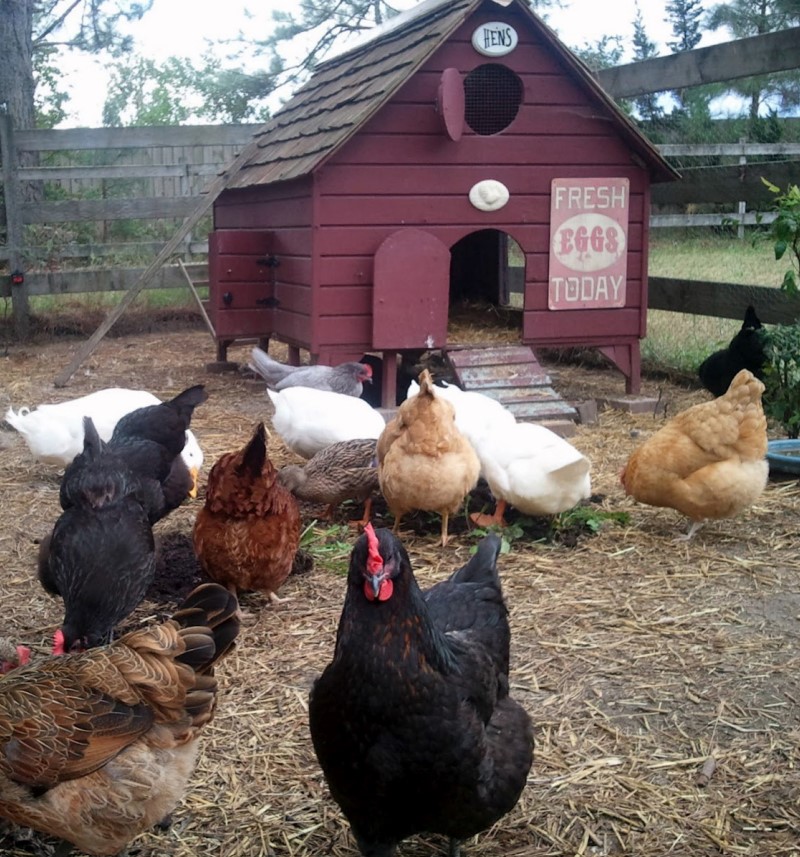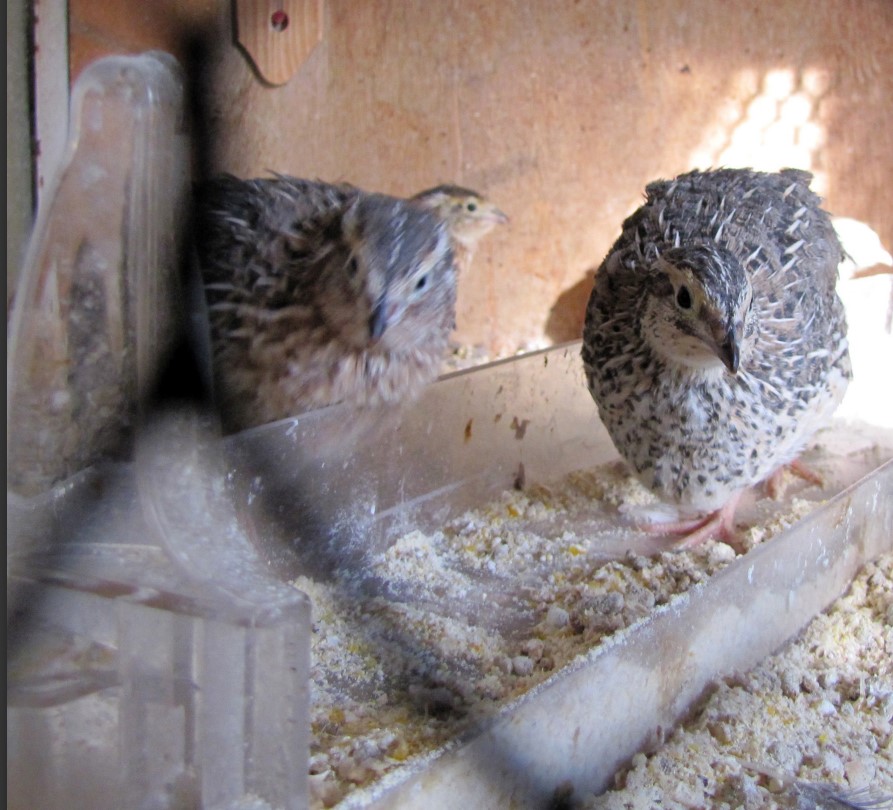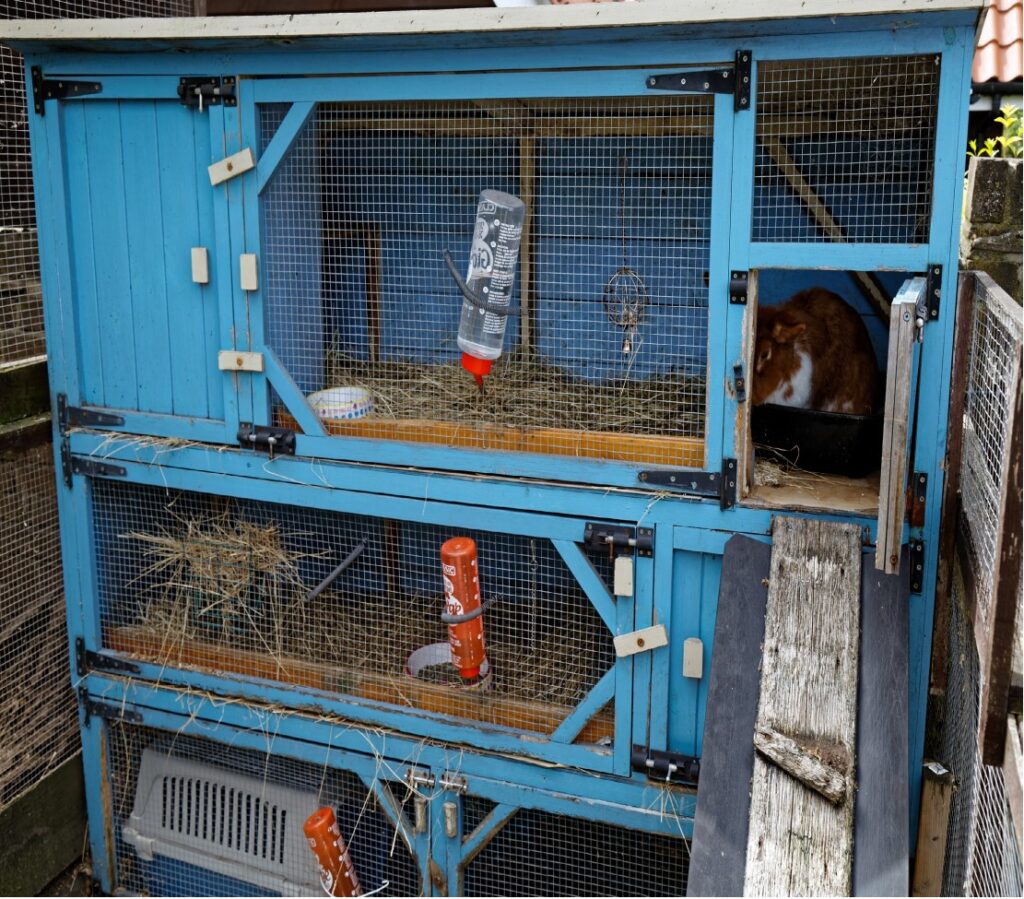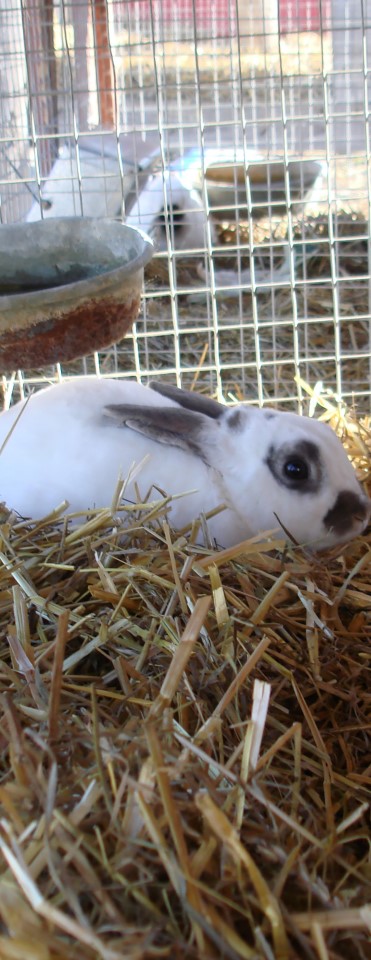Chickens
The most common entry point for people starting to raise livestock is chickens. That’s because they are rather easy to take care of and produce an abundance of eggs and meat for the pot. If you have the room, you can allow the birds to free-range and basically fend for themselves. Keeping some scratch and starter feed on hand will ensure your birds get the proper nutrition.
You don’t need much room for chickens. But, if you’re planning on allowing your flock to grow naturally, or even intend to incubate eggs, you’ll need a rooster. This is where most people run into issues with chickens. Most cities have prohibitions against backyard fowl. But it’s really the rooster people take issue with. His early morning wake-up call can be annoying – to the people not eating fresh eggs every day, that is.
Having a rooster will also afford your hens some protection. They are generally fiercely protective of their flock. The other benefit is fertilized eggs. This is how you can ensure the growth of your flock. If you’re lucky and have a broody hen, then there is nothing else you need to do. She will sit on them and raise them. But broodiness can happen infrequently. As an insurance policy, have a back-up incubator to allow your eggs to mature.
If you have chicks hatch out, it will take them about seven months to reach maturity and start laying eggs. Once they start, they will reliably lay for years. Winter production, if you live in a very cold area, can slow or stop entirely. But there are some tricks you can use. Chickens stop laying in the winter when the days grow shorter and the temperatures drop. You can trick them, as it were, with supplemental light and heat. If they’re comfortable, they will continue to produce eggs.
Chickens are pretty hardy and really don’t need much from you. As long as you provide them with a sturdy shelter, they will do the rest. Chickens like to roost, so make sure your coop has a place for them to get off the ground at night. They also like nests. Having adequately sized nesting boxes will keep your hens happy and keep you from having to search the yard for those eggs you know they are laying, but aren’t in the coop.
I always provide a fully enclosed coop for the birds to overnight in. I go out near sundown and check to make sure the birds are inside and close them up. In the morning, I come out and open the coop and they are free to roam around and search for food. I use those two times a day to look for eggs as well. It’s simple and easy.
The coop also contains a waterer and feed for the birds. The feed is to supplement what they scratch out on their own. Birds that are allowed to free-range produce a rich egg with an orange yolk. These are not the same eggs you buy from the store. They are far superior and worth the effort.
If you cannot allow the birds to roam free, you can always go the tractor route. The “tractor” is a small mobile coop that allows the birds access to the ground. The tractor typically has wheels on one end and a handle on the other. You can pick up the one end and roll the tractor to a new patch of ground every day, allowing the birds access to a fresh patch every day. Typically, this move is made in the morning before the birds are let out for the day. The chickens eat bugs, grubs and worms. They also eat plant material. So don’t be concerned if you don’t see an abundance of insects in the areas you’re planning on parking them for them day.
Tractoring chickens around the yard has the added benefit of spreading high quality manure around the yard and controlling ticks and other insects. The birds also till the soil through their scratching. All of this has added benefits to your home.
The last option is having a coop with an enclosed run. This provides the birds protection from predators, but denies them the ability to forage. Birds in a run will soon reduce the area to bare dirt. It doesn’t matter what the land looks like when you start, when the birds are done with it, it’ll be a bare patch of dirt.
If the birds are kept in this type of enclosure, you will need to feed them. That means you will only have chickens as long as you can feed them. If you’re looking at a long-term, sustainable food system, having chickens you can free-range is the answer. There are very little inputs required and they yield a lot of eggs and meat.
If you’re hatching out eggs, either through a broody hen or an incubator, you’ll want to keep an eye on the number of roosters that are being produced. A good rooster is worth its weight in gold. Having one that is gentle and interacts with the family is that rare find worth protecting. As young birds come up, they will want to challenge the dominant rooster. If your rooster is doing a good job and has a good temperament, then those young roosters need to be culled and sent to freezer camp, or to the stew pot.
The other benefit chickens provide is in producing bartering goods. The eggs, the meat, and even the birds themselves can easily be bartered. Your neighbors that don’t have their own chickens will surely want to start a flock if we’re in a severe crisis. There’s nothing like food being produced for you with very little effort on your part, right in your own yard.
Provide your birds a quality coop. Spread straw, pine straw or pine shavings in the bottom to collect their waste and change this weekly. Provide them plenty of water and wash out the waterer weekly to prevent the growth of algae. Allow your birds to free range and they will require very little else from you. Be sure and lock them up at night. Look at it as work release for your hard-working ladies. They spend the night in confinement and have all day to run around as they please. This will keep predation to a minimum.
Just like all livestock, you can only raise it so long as you can feed it. Chickens have the benefit of being able to feed themselves. But let’s say you have a small coop and cannot free range your birds. You’re out of feed but don’t want to butcher all your birds and be out of the chicken business. There is one other way you can feed them.
Tip: Take a five-gallon bucket and drill a bunch of quarter inch holes in the bottom. Toss any sort of meat scraps you can find into it. If you’ve butchered a bird, throw the carcass in there. If you’ve been hunting, toss the offal into the bucket. Hang the bucket over the run and wait. Soon, flies will start laying eggs into the carrion in the bucket. The maggots will fall through the holes and your chickens will be there waiting on them. This is also a great way to supplement their feed in normal times.
The pros of chickens are they are very self-sufficient and can be kept with little in the way of inputs. They produce eggs reliably and plenty of meat. The cons include various HOA restrictions against having them in your backyard. They need more space than other small-scale livestock. And like all livestock, you need to plan ahead and store feed for them.
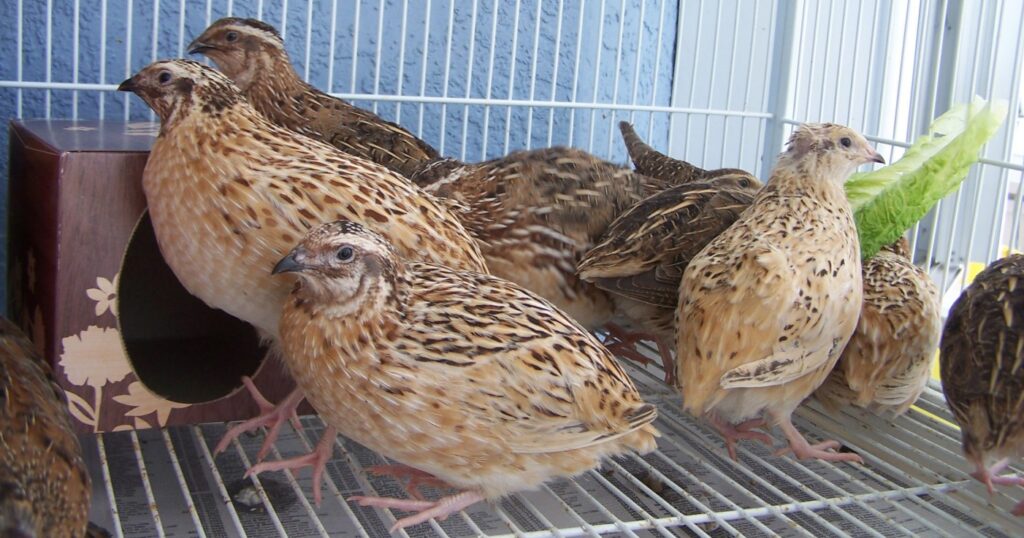
Quail
There are a number of solutions for those wanting to produce some of their own food but just don’t have the room. One of the first, and easiest, is quail. Quail are small, require little space and minimal inputs. Supplying them with sufficient feed and water will yield an abundance of eggs and fresh meat for the table.
Quail lay one egg per day, per female. It takes three to four quail eggs to make one chicken egg. This give you an idea of how many birds you should plan on to produce the quantity of eggs you need. And as the birds age, they can be turned into meat for the pot.
When planning on raising quail, pick a spot with protection from the elements. The birds are hardy, but they do need protected from extremes of temperature. The birds require about one square foot of space per bird. This is important to ensure proper health of the birds. Add straw or pine shavings to the bottom of the hutch or pen for sanitation and keep it clean to avoid causing illness in your birds.
Once the birds are big enough, they can even be put in hutches with wire bottoms to help keep them cleaner. You don’t want your birds laying in their own waste or having to live in it. By keeping their water and food clean as well, you will have few issues with raising the birds.
Eggs should be collected twice a day. Unlike chickens, quail do not like nests and do not perch. They live on the ground and lay eggs wherever it suits them. If you’re planning on incubating the eggs, you’ll need one male per hutch. If more than one is introduced, the dominant male will kill the others.
Just like chickens, quail egg production will slow or stop altogether in the winter. Short days and cold temperatures cause this drop. But you can trick them by providing light and heat. Providing up to fifteen hours a day of light will bring egg production back. More than that and the birds will start to suffer from lack of sleep. So, don’t push it too far.
With a male in the hutch, you will get fertilized eggs that can be transferred to an incubator. The birds will not hatch out their own, so if you want chicks, you’ll need an incubator. There are a few different varieties—still air, forced air, whichever you choose, watch your eggs closely. Once the eggs hatch, move the chicks to a brooder. Space here should be one square foot per four birds. Additional heat will be needed and the birds need to be kept about 95 degrees for the first few weeks.
Place a heat lamp over the brooder and place the food and water stations around the edges. If the birds are grouped under the lamp, they are cold. If they’re staying out from under it, around the edges, they are hot. Adjust your light accordingly. Feed the chicks a gamebird starter. This feed has a higher protein content than chicken starter that the birds need to grow. Feeding them chicken starter will cause your birds to grow much slower.
For the adults, look for a gamebird feed with between 25-28 percent protein. Adult birds will eat between 14 and 18 grams a day. A single 50-pound bag will provide nearly 500 days of feed to a single bird. This will give you an idea of just how much feed you need to store.
The pros of raising quail is the small footprint needed to house them. A hutch, eight-feet by two-feet by one-foot-high is plenty of space for 16 adult birds. That’s 16 eggs a day, from one hutch. The cons are, you cannot free range them; they fly quite well. Though, you could build an outside pen with poultry netting and give them access to the ground. The other con is that you can only raise them as long as you have feed for them. So, you are limited by the amount of feed you stock. But as shown above, they don’t eat much.
Rabbits
We’ve talked about a couple of poultry options. But maybe you want a red meat alternative. Rabbits are a great way to introduce meat into your food system. They do require a little more care than the birds we’ve discussed, but it’s nothing insurmountable. And, unlike chickens, there are few restrictions against the keeping of rabbits. And, even if there are, who’s going to know you have them?
Rabbits need to be kept in hutches where they will be protected from extreme elements like rain, snow, high and low temperatures. The hutches can be kept anywhere there is a little shade to keep them from overheating. Take time to plan the hutch location. Rabbits produce an abundance of manure. Using a wire bottom hutch will allow this high-quality fertilizer to fall through, keeping the hutch clean. This manure is the first product your bunnies will provide you. Unlike chicken manure, rabbit dropping are not hot and can be added to gardens immediately.
To get started with rabbits, you need a breeding pair. But to hedge your bets, it’s best to start with one buck and two does. A doe can have litters up to and even more than 17 to 20. Seventeen is a good number for a doe to nurse. More than that, and she’ll have a hard time. A single breeding pair of rabbits can produce 40 to 50 rabbits for your freezer a year.
You can breed a doe every 90 days and if you have more than one and keep records, you can stagger the breeding and produce a litter every six weeks or so. Gestation for rabbits is between 30 and 32 days. The bunnies will nurse for five or six weeks as they learn to eat solid food. At six to seven weeks, you can remove the bunnies and put them in another hutch. Separate the bucks and does to prevent incidental breeding of immature does.
These bunnies are your fryers and should be consumed over the next few weeks. As the rabbit matures, the meat will get tougher. So, it’s best to get them in the 8- to 12-week range. At this point, the fryers will average about three pounds in weight. They will also be easy to butcher as the skin will slip easily from the carcass.
The typical method of dispatching the rabbit is to break its neck. There are small devices that look like two hooks set at a slight angle to one another. The rabbit’s head is placed between the hooks. The hooks will hold the head in place. Gripping the back legs and giving them a firm yank downward will do the job. Another method is the broomstick. Place the rabbit on the ground and lay a broomstick over the back of his neck. Step on either side of the stick and again, grip the back legs and give a quick jerk to break the neck. Both of these methods are humane and fast.
Unlike the poultry we discussed earlier, rabbits need a little more in the way of inputs. Providing them with a high-quality hay is necessary, but a bale of alfalfa will go a very long way with rabbits. You can also feed them rabbit pellets. Rabbits will eat any vegetable scraps from the kitchen. They relish hard root varieties—Bugs Bunny was right about that.
In the long term, having a third-party feed could be an issue. But you can still feed your rabbits with a little effort. They will just as readily eat grass clippings, weeds you pull up and put in the hutch, or any sort of plant matter. If going this route, keep an eye on what they will and will not eat. Remove any plants you put in that they ignored and add more of the ones they liked. This is a way to turn your rabbit herd into a sustainable food source requiring no outside inputs.
When selecting your hutches, make sure they are not constructed of chicken wire. The wire needs to be large enough to allow the dropping to fall through, but not so large that the young bunnies can fall through. I learned this lesson the hard way as a kid when I came home from school and found new born bunnies all over the ground under my hutch.
Another thing to watch is your does. The doe that had the litter I mentioned above would not nurse them. I was too young to be able to do much about it and they all died. If you have a doe that will not take to her litter, dispatch her and try another doe. Inbreeding is not an issue, so a doe can mate with the buck that sired her.
The hardest part of raising rabbits is the family will see them as cute little bunnies and before long they will all have names. It seems to be the general rule of thumb that animals with names never make it to the stew pot. Start early emphasizing the fact these animals are for food. It will make it a lot easier when the time comes.
Aside from the meat, the rabbits will provide one other commodity: fur. The fur of the young fryers is fairly thin and not worth much, but there is a market for the older hides. As the animals age, the hide becomes worth more, requiring more food and time. But having a ready source of soft furry hides can come in very handy, especially if you live in a norther climate where it gets cold. Rabbit fur mittens are warm!
Final Thoughts
We’ve listed three ways you can get started in livestock. All three of these are fairly easy to get started and don’t require a lot of time on your part. They all will produce meat and other products for the table, and by raising your own protein, you’re establishing a sustainable food system. That’s what you’ll need in the event of a true crisis. The other benefit of these three animals is they are, for the most part, quiet and can even be raised indoors, like your garage. Take a look at your home and decide which of these would be best for you. Or maybe you have the room to try two or even all three of these adventures in livestock.
This article was originally published in Survival Dispatch Insider Vol. 2 Issue 7.

